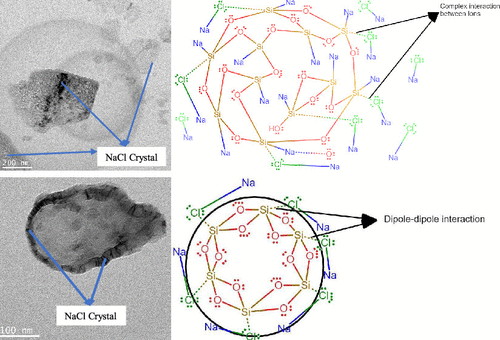当前位置:
X-MOL 学术
›
Ind. Eng. Chem. Res.
›
论文详情
Our official English website, www.x-mol.net, welcomes your
feedback! (Note: you will need to create a separate account there.)
Experimental Study on the Viscosity Behavior of Silica Nanofluids with Different Ions of Electrolytes
Industrial & Engineering Chemistry Research ( IF 3.8 ) Pub Date : 2020-02-13 , DOI: 10.1021/acs.iecr.9b06275 Saheed Olawale Olayiwola 1 , Morteza Dejam 1
Industrial & Engineering Chemistry Research ( IF 3.8 ) Pub Date : 2020-02-13 , DOI: 10.1021/acs.iecr.9b06275 Saheed Olawale Olayiwola 1 , Morteza Dejam 1
Affiliation

|
Understanding the mechanisms behind the interaction between the nanoparticles (NPs) and the brine/seawater is critical for successful oil recovery. In this study, the effect of ionic components of brine, including Na+, K+, Ca2+, Mg2+, Cl–, and SO42–, at different concentrations of silica NPs on the viscosity of the fluid is investigated for the first time. A comprehensive experimental study on the mechanisms behind the variation in the viscosity of silica nanofluids is presented. The results show that the cations present in the electrolytes increase the viscosity of silica nanofluids in the order of Na > Mg > K > Ca while the electrolytes with SO42– ion have a higher viscosity than those with Cl– ion. The interaction between the ions of silica NPs and electrolytes is classified into three different regions. In region I, the measured energy-dispersive X-ray of the transmission electron microscopy image shows that an interaction between the ions of silica NPs and the electrolyte anions in the electrical double layer results in the formation of a complex compound. In regions II and III, the electrolyte forms a protective layer on the silica NPs to isolate them from one another. The average size of particles in the nanofluid at a fixed concentration of electrolytes in regions II and III decreases at concentrations of silica NPs beyond the peak value, but only region I is observed at a constant concentration of silica NPs and varying electrolyte concentrations. These findings can improve the design and implementation of NPs for an efficient oil recovery.
中文翻译:

不同离子型二氧化硅纳米流体粘度行为的实验研究
了解纳米颗粒(NPs)与盐水/海水之间相互作用的背后机制对于成功采油至关重要。在这项研究中,研究了不同浓度的二氧化硅NPs盐水中的离子成分,包括Na +,K +,Ca 2 +,Mg 2 +,Cl –和SO 4 2–对流体粘度的影响。首次。本文对二氧化硅纳米流体的粘度变化背后的机理进行了全面的实验研究。结果表明,电解质中存在的阳离子以Na> Mg> K> Ca的顺序增加二氧化硅纳米流体的粘度,而含SO 4的电解质2 –离子的粘度高于Cl –的粘度离子。二氧化硅NPs离子与电解质之间的相互作用分为三个不同的区域。在区域I中,测量的透射电子显微镜图像的能量色散X射线表明,双电层中二氧化硅NPs的离子与电解质阴离子之间的相互作用导致形成络合物。在区域II和III中,电解质在二氧化硅NP上形成保护层,以将它们彼此隔离。当二氧化硅NPs的浓度超过峰值时,在固定浓度的电解质中,在纳米流体中,纳米流体中颗粒的平均尺寸会减小,但是在恒定浓度的二氧化硅NPs和变化的电解质浓度下,只能观察到区域I。
更新日期:2020-02-14
中文翻译:

不同离子型二氧化硅纳米流体粘度行为的实验研究
了解纳米颗粒(NPs)与盐水/海水之间相互作用的背后机制对于成功采油至关重要。在这项研究中,研究了不同浓度的二氧化硅NPs盐水中的离子成分,包括Na +,K +,Ca 2 +,Mg 2 +,Cl –和SO 4 2–对流体粘度的影响。首次。本文对二氧化硅纳米流体的粘度变化背后的机理进行了全面的实验研究。结果表明,电解质中存在的阳离子以Na> Mg> K> Ca的顺序增加二氧化硅纳米流体的粘度,而含SO 4的电解质2 –离子的粘度高于Cl –的粘度离子。二氧化硅NPs离子与电解质之间的相互作用分为三个不同的区域。在区域I中,测量的透射电子显微镜图像的能量色散X射线表明,双电层中二氧化硅NPs的离子与电解质阴离子之间的相互作用导致形成络合物。在区域II和III中,电解质在二氧化硅NP上形成保护层,以将它们彼此隔离。当二氧化硅NPs的浓度超过峰值时,在固定浓度的电解质中,在纳米流体中,纳米流体中颗粒的平均尺寸会减小,但是在恒定浓度的二氧化硅NPs和变化的电解质浓度下,只能观察到区域I。











































 京公网安备 11010802027423号
京公网安备 11010802027423号